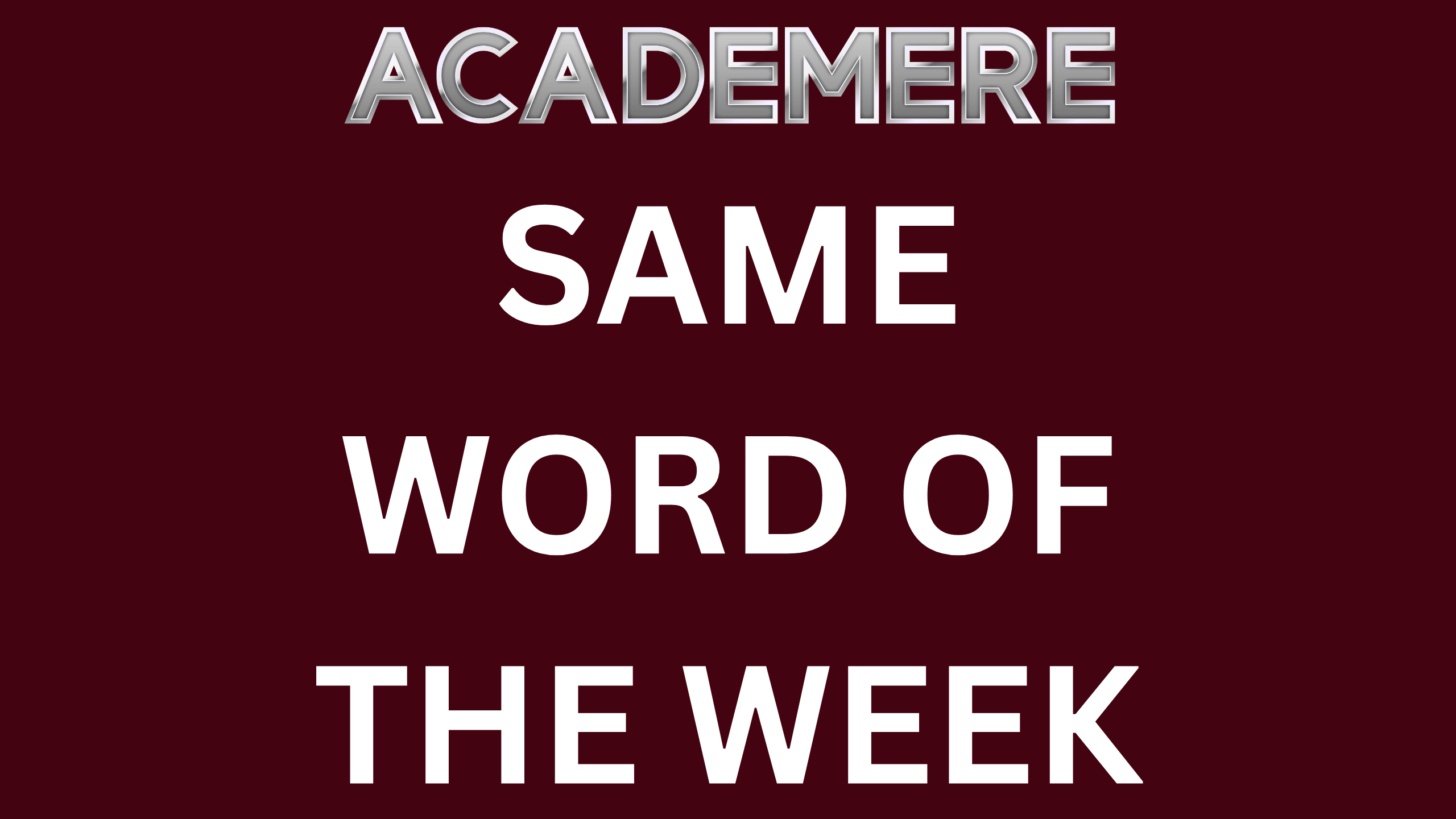

The Word of the Week: Same – Academere
To take a trivial example which of us ever undertakes laborious physical exercise except.


The Word of the Week: Same – Academere
To take a trivial example which of us ever undertakes laborious physical exercise except.
The Word of the Week: Same – Academere
The Word of the Week: Same – by Academere
1. Introduction to “Same”
This week’s “Word of the Week” is “same,” a simple yet powerful term that plays a crucial role in comparison, identity, and consistency. The word “same” is used to indicate that two or more things are identical in some or all aspects. It can serve as an adjective, pronoun, or adverb, depending on the context in which it is used. For example, “They wore the same outfit” shows it as an adjective, while “He did the same” shows it as a pronoun. Though often overlooked due to its commonness, “same” is essential in everyday communication. It helps us express equality, uniformity, and repetition clearly and efficiently. Its etymology traces back to Old Norse sami and Old English same, both meaning “identical.” Despite its simplicity, “same” carries significant implications in logic, identity, and philosophy. This word teaches us the value of clarity, precision, and shared understanding. In this article, we will explore the many roles, uses, and meanings of the word “same” in depth.
2. Meaning and Usage in Sentences
The word “same” indicates that there is no difference between two or more things. It is often used to avoid repetition and to highlight similarities. For instance, instead of saying, “She went to the store, and he went to the store,” one can say, “She went to the store, and he went to the same.” In another example, “We have the same opinion,” it shows complete agreement or alignment. The phrase “same here” is commonly used to express mutual experience or feeling. In logical contexts, “same” is used to assert identity—“A and B are the same thing.” It can also imply repetition: “He did the same thing yesterday.” The word often serves to streamline communication by replacing longer, redundant phrases. Understanding how to use “same” can help speakers be both precise and efficient. Though simple, its functionality is broad and essential for clear communication.
3. Parts of Speech and Grammatical Forms
“Same” is primarily used as an adjective, but it also appears as a pronoun and occasionally as an adverb. As an adjective, it describes something that is identical to another, such as in “They arrived at the same time.” As a pronoun, “same” can stand in for a previously mentioned noun: “I’ll have the same.” As an adverb, although rarely, it can be used in formal or poetic contexts, as in “He acted same as before.” The phrase “the same” often includes the definite article to clarify the shared subject. It can also function in idiomatic expressions such as “same old story” or “all the same,” which may carry additional emotional or contextual meaning. Plural and comparative forms like “sameness” (noun) and “similarly” (adverb) are related but distinct. While “same” doesn’t change form like verbs or some adjectives, it remains versatile through sentence placement. Grasping its grammatical use enhances both written and spoken fluency. Recognizing its syntactic role enables more nuanced and accurate expression.
4. Philosophical and Logical Dimensions
In philosophy and logic, “same” is a term packed with abstract significance. Identity theory, a key topic in metaphysics, often uses “same” to explore the idea of what makes something itself and not another. For example, is a person who changes over time still the same person? In formal logic, the concept of sameness is critical in establishing equivalency and consistency across arguments. The Law of Identity—“A is A”—is a foundational principle that illustrates this. Philosophers also use “same” when discussing time, memory, and personal identity. In ethics, sameness can be used to argue for equal treatment, such as “All humans deserve the same rights.” From a psychological perspective, the feeling of being the “same person” over time contributes to self-continuity. Such inquiries highlight how deeply rooted “same” is in understanding reality and selfhood. Though the word may appear simple, its philosophical weight is immense. Studying it through these lenses reveals how language shapes our worldview.
5. Cultural and Social Interpretations
In society, the concept of “same” often intersects with ideas of equality and conformity. Social movements use “same” in phrases like “same rights” or “same opportunities” to demand justice and fairness. Conversely, cultural critique may highlight the dangers of forced sameness, such as in systems that discourage individuality. Uniforms in schools or workplaces promote sameness to foster equality or discipline, but can also suppress expression. In relationships, people may bond over shared experiences—“We went through the same thing.” Yet, emphasizing sameness can sometimes erase diversity or nuance. In marketing, brands may use slogans like “same great taste” to emphasize consistency and trust. Cultural norms around food, behavior, and language often encourage sameness within communities. However, global interactions increasingly celebrate both sameness and difference. Understanding how “same” is perceived culturally helps us navigate shared values and diverse perspectives. The term plays a complex role in balancing unity and individuality.
6. Emotional and Psychological Uses
Emotionally, the word “same” often signals connection and empathy. Saying “I feel the same” can comfort someone and build rapport. It creates a bridge of shared understanding and reduces feelings of isolation. On the other hand, being in the “same routine” or doing the “same thing every day” might signal boredom or stagnation. This duality gives “same” emotional depth, depending on context. In therapy or counseling, exploring when and why something feels the same can reveal patterns in thought or behavior. “Same triggers” or “same arguments” may indicate unresolved issues or cycles. People may seek change precisely because everything feels too much the same. Yet, for those recovering from trauma, a sense of sameness—of stability—can be healing. This illustrates how “same” can represent both comfort and constraint. Its psychological power lies in its ability to reflect our internal states and external environments simultaneously.
7. Same in Technology and Mathematics
In technology and mathematics, the word “same” is foundational to understanding systems and equations. In coding, conditions often rely on determining if two variables are the same—e.g., if (x == y). In data science, ensuring that datasets follow the same format is crucial for analysis. Software updates often aim to keep user experience the same while improving functionality. In mathematics, equality signs (=) express that two values are the same, forming the basis of algebra. Concepts like “same size,” “same shape,” or “same value” are key to geometry, physics, and logic. Standardization relies on sameness to ensure compatibility and accuracy across different systems. In AI and machine learning, models learn by detecting patterns and similarities—forms of “sameness” in large datasets. File comparison tools check if documents are exactly the same down to the byte. Even search algorithms rely on recognizing the same or similar content across websites. In this realm, sameness ensures predictability, trust, and precision.
8. Conclusion: The Power in Simplicity
Though it is a short and commonly used word, “same” carries profound significance across disciplines and experiences. It helps us compare, connect, understand, and organize both thoughts and objects. Whether expressing identity, agreement, stability, or repetition, “same” performs critical communicative functions. Its grammatical versatility as an adjective, pronoun, or adverb makes it a useful tool in both writing and speech. In philosophy, psychology, and science, “same” invites deep inquiry into identity and change. Socially and emotionally, it fosters empathy and shared meaning. Technologically and mathematically, it provides the foundation for logic and functionality. By exploring this deceptively simple word, we enhance our awareness of how language shapes perception. “Same” reminds us that clarity and connection often rest on the most basic elements. This week, let us reflect on “same” not only as a word, but as a lens through which we view the world, ourselves, and each other.
